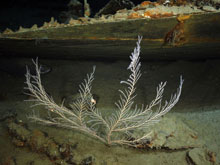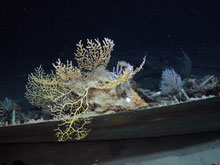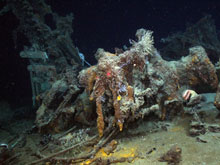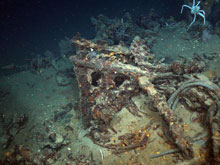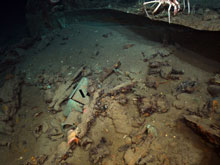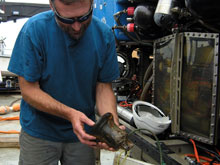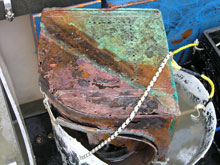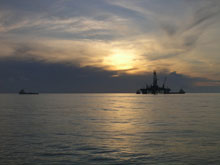
Sunset creates the tone for the start of the dive. Click image for larger view and image credit.
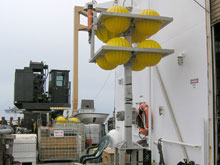
The decision had to be made early in the dive whether or not to deploy "The Elevator." Click image for larger view and image credit.
¡Luz Verde de Estribor!
September 9, 2009
Lori Johnston
Harry Roberts
Louisiana State University
Sheli Smith, PhD
PAST Foundation
Excitement, anticipation, anxiety. . . If we were to sum up the events of the day, these were the emotions everyone felt. From the moment we came in from the Ewing Bank dive, we began to plan and strategize for the final and most complex recovery we had scheduled. The entire day was filled with excitement, from the breath-holding tension we all experienced in the Zen Van as we executed the tasks to the anxious anticipation as we all rushed out on the stern deck to greet Jason's return. It was like Christmas morning as we pressed in to see if the fragile artifacts made it to the surface intact.
The long dive began at 4 p.m. GMT, when the remotely operated vehicle (ROV) Jason went in the water. Erik led the pre-dive science meeting, laying out the long plan. It would take over two hours just to mosaic the site. In addition, there were bio transects, bio collection, rusticles to be seen and had, and the shipwreck to study, as well as the artifact recovery. Jason would not return to the surface until noon the next day.
A Word in Spanish
The Green Lantern wreck is currently unidentified. C & C Technologies found the wreck during a deep tow survey in 1996, then resurveyed with the C-Surveyor I autonomous underwater vehicle (AUV) in 2004. A copper-clad sailing vessel, the wreck measures approximately 20 meters (66 feet) in length. Named for one of the ship’s lanterns found lying just outside the stern, the embossed word Estribor, Spanish for "starboard," caught the attention of the surveyors. Just like modern ships, historic vessels ran a green light on the starboard side and a red lantern on the port side.
In addition to the lantern, we planned on recovering other artifacts, including a fork, patent sheave, and ship’s bell. The bell, in particular, posed a serious challenge to the skill of the ROV pilots. It was nestled in a precarious position. Retrieving it without damaging the artifact, fragile wreck, and nearby coral, would be extremely difficult.
Decision Time
The Virtual Van team softly plays Rolling Stones music as we push through the tasks. Our first decision was whether or not to deploy The Elevator for artifact recovery. Although Jason has a front porch and two side trays for storing sampling, many tools and trays "live" on those platforms — all fairly small in size, in keeping with the types of biological recovery being made. The three-inch-diameter quivers can hold two distinct biological specimens, while the two, six-inch-diameter tubes on the bow and the two bio boxes on the side trays can hold bigger pieces. A large, plastic milk carton on the front porch can accommodate 10 cores. However, the front porch also is home to the slurp, the Aquapix camera, the scoop basket and all the corks for the quivers, leaving very little room for anything else. So, if the bell or the lantern were too big for the boxes or bucket, a separate platform with larger boxes (known as The Elevator) would have to be deployed; Jason would then have to retrieve it and bring it near the site for the recovery operation.
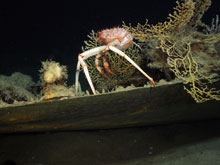
Spiny crabs crawl all over the wreck site. Click image for larger view and image credit.
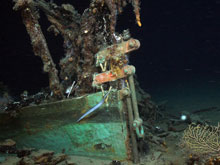
The bobstay fasteners are attached with modern hex nuts. Click image for larger view and image credit.
Once on the bottom (via Jason), we went directly to look at the lantern and the bell so that we could make the deployment decision, a decision that would eat up two hours of our bottom time. Luckily, the objects were smaller than we feared, and the decision was made to use the boxes on hand. That decision then made strategizing the recovery order extremely important. Everything had to have its place designated well in advance, so that we could accommodate it all.
In Search of Rusticles
By 2 a.m. EDT, Peter and Cheryl had some awesome pictures of life on the wreck, and we were ready to photograph construction and search for "The Rusticle." Ben took the helm as we spotted a beauty hanging off the stempost. Jokes flew around the van: “Redemption Time.” Time to get a perfectly intact rusticle for Lori. Using one of the vacant coring tubes as a recovery tool, Ben sleeved the little devil and safely stowed it.
Time for artifact recovery, and everyone was on hand as the process started, too curious and too anxious to sleep. As the night wore into morning, the process of recovery began. First, the fork. For such a small little artifact, it proved a pesky task. Bob was able to push it gently toward Lori’s pagoda experiment and (unintentionally) the utensil slid onto the bottom plate. By lifting the pagoda, he was able to shift the fork to a more open area for recovery.
Next, the sheave. We were looking for a patent sheave to help date the wreck and thought we found one in the stern. Bob was able to expertly pluck it off the seabed and safely store it in one of the side tray boxes. Then the plate lying just inside the starboard stern was recovered and also stored safely in a box. Three down and just a couple more artifacts to go, but the last two — the bell and lantern — were the worrisome pieces. The first was problematic because of its location nestled deep within a conglomeration of artifacts including the glass pane from a porthole; and the second because of its fragile nature.
The shift changed and Matt set up for the bell. He positioned Jason just outside the hull; the team worked to maintain perfect altitude just off the seabed while Matt manipulated the arm, reaching in over the glass to pluck the bell. It definitely sounds easier in the retelling, but at the time Matt was reaching blind, having lost visuals of the object on all three Jason cameras once the arm was down in tight space.
Everyone held their breath as the newly rubberized fingers of the arm slowly extracted the ship’s bell. All eyes were riveted on the camera screens, hoping to catch a glimpse of a name on the bell, but none could be seen. Many bells were cast specifically for a ship with its name and it is always the hope that finding a bell will quickly lead to identification of the shipwreck. Into the bio box on the starboard side went the bell, without incident; and Jason moved back to the stern for the lantern.
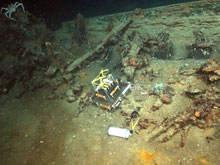
Another pagoda micro-biological experiment was set on the wreck, along with the short-term exposure experiment. Click image for larger view and image credit.
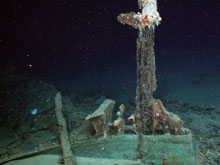
The ship's rudder is still intact and the attachment to the sternpost is visible. Click image for larger view and image credit.
Recovering the Lantern
Recovering the lantern was a big risk. We were prepared at any moment to call it off if the artifact was endangered or too fragile. Carefully, and with much discussion, we examined the artifact, setting up slowly for the recovery. Matt put in a request for music, and we went in, testing the remaining strength of the copper lantern walls. The van was full as we all watched and waited. With excruciating patience and precision, Matt nudged the lantern loose and found a place to grip and lift. The small glass pane of the back window lay in plain sight, but we could only guess on the green lens. Slowly, the lantern came away from the bottom, holding together.
As if that wasn’t difficult enough, the next step was even more tricky. Getting the lantern into the bucket for the ride to the surface required careful movements if we were to avoid both losing the small glass pane and putting undue pressure on the thin walls. As Matt swiveled the lantern sideways,
Jason's lights caught the reflection of the green lantern glass still in place and a chorus of “Ahhhs” went up around the room.
The decision was made to stand the lantern on its chimney in the bucket. Slowly the lantern rotated, and we all held onto our breath. At the last minute, the fractured lens slipped and as the lantern slid neatly into the bucket the lens fragment fell out. All eyes began to dart around the screens, trying to figure out where it had fallen. The team moved Jason and we all looked at the surrounding seabed — no glass. Where had it gone? Then it was spotted, perched precariously on the strut of the porch, held in place by the head of a bolt. A tap knocked it down onto the porch floor, where we could see it but not get to it, and where we hoped it would ride safely to the surface. The tension in van evaporated, and jokes and laughter prevailed.
We had 20 minutes left in the dive. Returning to the location of the lantern, Matt retrieved what we thought was the chimney cap and stowed it with the fork. We had just enough time to investigate the other lantern, which Jake and Matt joked would make a nice matched set, if we wanted to retrieve them. But our nerves as well as the space on Jason were gone. So, right on time, Jason lifted off the bottom and headed for the surface.
The aft deck of the NOAA ship Ronald H. Brown was full — cameras were at the ready. The conditions on the surface were near perfect, the seas flat as glass. (This was good news for all the artifacts resting on the front porch). As soon as it was safe, Matt inspected the porch and gave the "thumbs up" on the lantern lens: it had made it to the surface on the floor of the porch.
Jake, with boxes scavenged from every possible location, began transferring the objects. First the bell came out of its box. Turning it around, we could find no visible markings cluing us in to the name of the vessel. Next came the lens. Holding it up to the light, we could see it was thick, green glass, with the distinctive bulbous shape of a navigational sidelight. Out of the large tube came the fork, and what we thought was the lantern lid. Just lifting the lid, the weight told us it was something else. Upon close inspection, we realized we recovered a small metal box that — judging by its weight— suggested there was something inside. What that something is remains a question.
Time to get back to logging data. The next dive will take us to the modern WWII shipwreck of the Gulf Penn. We are going to look to inspect the huge Lophelia colonies discovered in 2004.




























